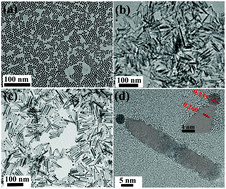Plasmon-induced hot electron transfer in Au–ZnO heterogeneous nanorods for enhanced SERS†
Abstract
Colloid-synthesized matchstick-shaped Au–ZnO heterogeneous nanorods are found to have the Zn ion terminated plane in the ZnO–Au interface without the formation of Au–O bonds based on the atomic-resolution observation of their interfacial structure and electronic states, which is greatly different from the other reported results. The Au–ZnO heterogeneous nanorods with a good expitaxial interface have shown a stronger surface-enhanced Raman scattering (SERS) signal of the dopamine molecules than Au nanoscale seeds alone, which is attributed to the enhanced charge transfer (CT) effect of ZnO which is greatly improved by the plasmon-induced hot electron from Au nanostructures. The enhanced CT effect has also been proved by a higher photocatalysis efficiency. Furthermore, the plasmon-induced hot electron transfer mechanism in Au–ZnO heterogeneous nanorods has been confirmed by a slow rise time of electrons in the transient absorption measurements. These findings suggest the dependency of the plasmon-induced hot electron transfer mechanism on the different mixing of the metal and semiconductor band levels.



 Please wait while we load your content...
Please wait while we load your content...